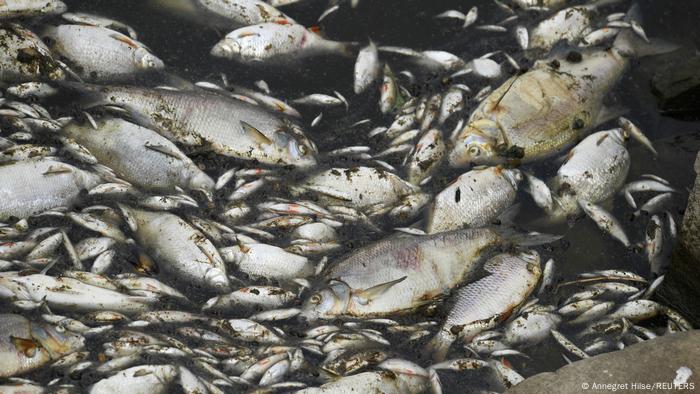Poland says toxic algae may explain Oder River fish die-offs
The Polish government says experts have found toxic algae in water samples from a river on the Polish-German border. Thousands of dead fish have appeared along the Oder River after mass die-offs in recent weeks.

Some 36 metric tons of dead fish have been recorded on the German side of the river alone
Polish Environment Minister Anna Moskwa announced on Thursday that lab tests showed toxic algae in water samples from the Oder River, which straddles Poland and Germany.
The discovery could explain the mass deaths of fish along parts of the river that had left experts baffled about the cause.
What's the latest?
The discovery of toxic algae could explain the fish deaths, but raises another question about what caused the algae to be present in large numbers.
"After further investigations, the Institute of Inland Fisheries in Olsztyn has found rare microorganisms, so-called golden algae, in water samples from the Oder river," Environment Minister Anna Moskwa said.
Moskwa said the blooms could cause the appearance of toxins that kill fish and clams. However, they are not harmful to humans.
German Environment Minister Steffi Lemke on Wednesday said the disaster had killed an estimated 36 tons of fish tallied in Germany alone.
What is golden algae?
Many species fall under the golden algae umbrella, but the term generally refers to just one in relation to fish deaths through toxicity — Prymnesium parvum.
The species produces several toxins, including ichthyotoxin — which specifically affects gill-breathing organisms such as fish, bivalves, crayfish, gilled amphibians, and also some species of plankton.
High levels of salinity, sulfate, and chloride have the greatest influence on golden algae distribution and bloom formation in inland waters.
Climate change could play a role, with higher temperatures leading to more water evaporating from inland waters and higher salinity levels.
The die-offs come as Germany experiences one of its driest summers in recent memory, with river levels falling across much of the country.
A puzzling phenomenon
Experts were left scratching their heads over the death of thousands of fish last week in the Oder River that borders Germany and Poland, near the eastern city of Frankfurt an der Oder.
Just two weeks earlier, Polish anglers had reported removing tons of dead fish from the Oder near the town of Olawa, about 300 kilometers (186 miles) upstream.
At the time of the reports in Poland, water authorities based in the nearby Polish city of Wroclaw detected a toxic substance in two locations on the Oder, thought to be the solvent mesitylene, which is known to have a harmful effect on fish. However, subsequent tests showed no trace of the substance.
Mercury was also identified as a potential culprit for the more recent die-off, but tests for the element and other heavy metals proved negative. Lab tests did show high levels of salinity in the water.
Local authorities have warned residents, along with their pets and livestock, not to touch the river water.
Warsaw has also previously said a chemical dump could be to blame — and offered a reward for information.
The European Commission on Thursday welcomed the establishment of a joint German-Polish task team and said it was prepared to send its own experts to work with the group.
"The sooner we can identify the cause of this ecological disaster, the sooner we can start to manage and limit the further consequences for nature, for fisheries, for agriculture, and for recreation," a spokesperson said.
Edited by: Kieran Burke
No comments:
Post a Comment